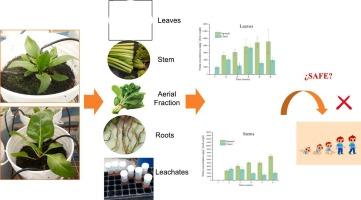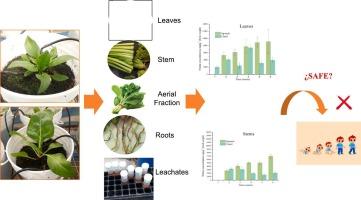探讨甜菜和菠菜中硝酸盐的吸收、积累和分布及其对食品安全和人体健康的影响
IF 9.8
1区 农林科学
Q1 CHEMISTRY, APPLIED
引用次数: 0
摘要
温室蔬菜生产通常与氮肥的过量使用和硝酸盐的高积累率有关。研究了温室条件下甜菜和菠菜对硝酸盐的吸收、转运和积累。结果显示,渗滤液和基质(甜菜、菠菜)中的硝酸盐含量较低。与甜菜相比,菠菜根区硝酸盐浓度高与茎、地上部分和叶片中硝酸盐积累速率高相关(p <; 0.0001)。菠菜中硝酸盐的浓度超过国际规定的标准3倍。几乎所有年龄组(13-19 岁除外)的硝酸盐日摄入量均超过可接受日摄入量(ADI)值。然而,在1 - 2 岁年龄组中,每日摄入量(7.87 mg NO3−kg−1)是ADI的两倍。为了提高儿童食品的质量,食品污染监测项目必须确保遵守生产标准。本文章由计算机程序翻译,如有差异,请以英文原文为准。


Exploring the uptake, accumulation, and distribution of nitrate in Swiss chard and spinach and their impact on food safety and human health
Greenhouse vegetable production is often associated with the excessive use of nitrogen fertilizers and a high rate of nitrate accumulation. We evaluated the uptake, translocation, and accumulation of nitrate in chard and spinach under greenhouse conditions with optimal fertilization. The results revealed low levels of nitrate in the leachates and substrates (chard ˃ spinach). The high nitrate concentrations in the root zone of spinach compared to those of chard were correlated with a high rate of accumulation in the stem, aerial fraction, and leaves (p < 0.0001). The nitrate concentration in spinach exceeded the limit established by international regulations by 3-fold. The daily intake of nitrate exceeded the acceptable daily intake (ADI) value in almost all age groups (except 13–19 years). However, in the age group of 1–2 years, the daily intake value (7.87 mg NO3− kg−1) was two times higher than the ADI. To improve the quality of food for children, food contamination monitoring programs must ensure adherence to production standards.
求助全文
通过发布文献求助,成功后即可免费获取论文全文。
去求助
来源期刊

Food Chemistry
工程技术-食品科技
CiteScore
16.30
自引率
10.20%
发文量
3130
审稿时长
122 days
期刊介绍:
Food Chemistry publishes original research papers dealing with the advancement of the chemistry and biochemistry of foods or the analytical methods/ approach used. All papers should focus on the novelty of the research carried out.
 求助内容:
求助内容: 应助结果提醒方式:
应助结果提醒方式:


